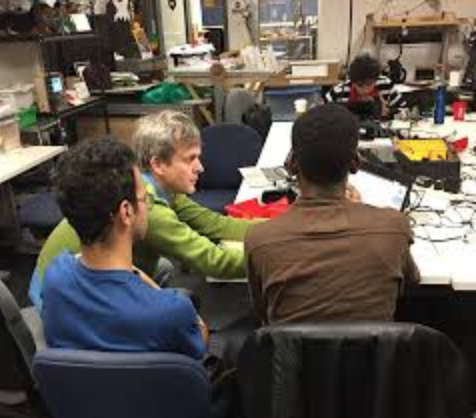
Ethan Danahy, Research Assistant Professor at Tufts Center for Engineering Education and Outreach (CEEO), was asked to speak by Tufts Center for Enhancement of Learning and Teaching (CELT) to discuss his use of “flipped classrooms” and remote teaching in a recent interview with Arduino Education. However, the COVID-19 pandemic caused Professor Danahy to shift to remote learning (read more about Tufts Remote Learning here). Although it did provide some difficulties, especially as Professor Danahy was not able to teach with his regularly-used “flipped” teaching style, he was able to adapt to this challenge. For the past few years, he, along with other Tufts professors, had been researching the implementation of Visual Classrooms [https://visualclassrooms.com/], a startup that allows professors to digitally ask their students questions and allow the students to respond online. Software like Visual Classroom and Zoom have allowed Professor Danahy to quickly shift to this new style of teaching. He recommends the use of Zoom’s breakout rooms in order to foster small group discussions, the creation of assignments that allow students to always be engaged in the learning of content, and an open line of communication between students and professors through applications like Piazza, especially during this pandemic in order to maintain a strong student-professor relationship. Although there are benefits and drawbacks associated with remote learning, Professor Danahy suggests that one of the most overlooked and important parts of this transition is the role of school or university leadership. School administration needs to find the right amount of external directives placed on professors in guiding remote learning. Too many external directives will constrain professors, but too little involvement will make professors feel unsupported, especially in a period where professors are looking for the necessary resources and support to make the transition to remote learning.
Dr. Ethan Danahy and Dr. Merredith Portsmore discussed the implementation of the “flipped classroom”, where emphasis is placed on opportunistic collaboration instead of teacher-centric classes with small groups. Dr. Danahy teaches a class titled “Intro to Engineering, Robotics”, where he creates active engagement, hands-on learning, and projects in order to teach instead of traditional teaching methods in the classroom. One of the methods he uses to create an engaging class is increasing accessibility of lectures, by posting videos of lectures and note guides. With increased accessibility for lectures, class time is now more dedicated to group work, where Professor Danahy is able to get to know his students better, and discussing topics covered in the lecture video more in-depth. Through this, he learned to listen to students in order to hear their struggles so that videos and lessons can be tailored to them, and to prompt students with open-ended problems for them to struggle with and explore. In creating a flipped classroom for the Fall 2020 semester, Professor Danahy wants to implement small-group discussions in Zoom breakout rooms, using technologies like TED Talks and Canvas quizzes in order to check students’ understanding, using Visual Classrooms and Piazza in order to document student thinking when not all students like to talk in-person. With the COVID-19 pandemic, there are going to be inevitable limitations to creating a flipped classroom, but this style of teaching allows for greater collaboration between students, and between students and teachers.